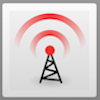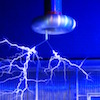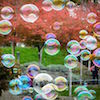Friday Flyer - October 4, 2024

Spotlight on Autumn 2024 - A Look Ahead
First of all, apologies to our avid readers in the southern hemisphere: For you, the title of this section should be Spotlight on Spring 2024. Please make appropriate substitutions as you read.
QuarkNet and our collaborators, like the school year, are getting into full swing. You will see more detailed information on most of what is going on below and in future Friday Flyers, but we will just try to get a feel for it here.
QuarkNet Educational Discussions (QED) is already underway. The first meeting of the school year was held in September and was very well-attended. This meeting was for getting back together, checking in, and planning. It looks like some great speakers are being lined up for future meetings.
Two big dates are coming up in November: World Wide Data Day (W2D2) on the 14th and International Cosmic Day (ICD) on the 26th. Registrations are open for W2D2, and we hope you will participate with your students. The integrated time that goes into it, from soup to videocon, is no more than about two hours, and it is designed for you to do at school. We should mention, by the way, that FF saw some of the Data Quality Management plots for CMS, and one or two look very much like plots that the students build together for World Wide Data Day.
As for International Cosmic Day, offered by our colleagues at DESY Zeuthen, well, it is another great opportunity. If you have any any sort of cosmic ray detector— the QuarkNet CRMD, the Cosmic Watch, or something else—you and your students can participate and contribute results from your experiment. If you do not, another perfectly good approach is to analyze data in the Cosmic Ray e-Lab or the data provided by ICD and participate.
Did we forget Dark Matter Day around October 31? Not at all! We do not have a planned activity for this, but you can either find one in your area by going to the Dark Matter Day site or you can create your own. If you can, drop Shane or Ken a line to let us know what you do.
What else? Send us your ideas!

News from QuarkNet Central
Upcoming Dates:
- World Wide Data Day (W2D2): Registration is now open for World Wide Data Day 2024, which is set for November 14, 2024.
- International Cosmic Day 2024: The 13th International Cosmic Day will take place on November 26, 2024. Click here for more information, including how to register.
- AAPT Winter Meeting 2025: The AAPT WM 2025 will be held January 18-21, 2025, in St. Louis, MO. The deadline for submitting a presentation for WM25 is Wednesday, October 9. Click here to submit a presentation.
- Kavli Institute for Theoretical Physics Teacher Conference: The 2025 KITP Teacher Conference will focus on particle physics and will take place in Santa Barbara on February 8, 2025. Stay tuned to future Friday Flyers for more information.
- International Masterclasses 2025: Fermilab-based International Masterclasses will be held March 10 - April 11, 2025. Stay tuned to upcoming Friday Flyers for future updates.
About the new QuarkNet website: Remeber that while our old site allowed users to login using their email address as their username, the new site does not. Please use your standard username. While you are logged in, please check that your Profile is up-to-date and complete. If you need help, contact Shane or Ken.
Teacher and Mentors with QuarkNet Cosmic Ray Detectors: Please ensure your detectors are up and running and that you are at least periodically uploading data to the Cosmic Ray e-Lab. Need help? Contact Mark Adams (adams@fnal.gov) or Dave Hoppert (hoppert@fnal.gov) for assistance. If you are no longer using your detector, please contact Dave Hoppert (hoppert@fnal.gov) in order to return your detector to Fermilab at Fermilab's expense. Reminder: These detectors are the property of Fermilab, and must be returned if they are no longer being utilized.

Physics Experiment Roundup
We have interesting news from CERN, and we start not with the LHC but with a fixed-target ecpeiment, NA-62. According to CERN Bulletin, this experiment found an ultra-rare decay: a specific flavor of kaon going to a pion and two neutrinos. How rare is this? Try one in ten billion.
In the ALICE experiment, physicists are wrking on the very difficult three-body problem. As you know, predicting the dynamics of three objects connected by gravity is a thorny problem best left to numerical methods. The people at ALICE are working on this experimentally but for particles connected by the strong interaction.
For the experiments to have the data they need, the LHC must deliver: and it has, reaching the integrated luminosity milestone of 100 fb-1 (inverse femtobarnes) in mid-September. Ten days later, it was up to 110 fb-1. That is a lot of collsions making a lot of particles and a lot of data for some intersting results, especially in light of what CMS and ATLAS found, as mentioned in our previous edition.
Symmetry Magazine tells us that we can assemble that data to give theorists hints of new physics from anomalous results.
Looking for bigger particles and bigger detectors? APS Physics has an example: using the solar system to detect black holes.

Resources
CERN Bulletin has even more for us. There is this major event: CERN celebrated its 70th birthday this week! (Video highlights included!) We have more on that from CERN Driector General Fabiola Gianotti and and important LHC update from CERN Director of Accelerators and Technology Mike Lamont. Speaking of that, here is a look back at the LHC switch-on in 2008.
And yet more: Beamline for Schools (BL4S) 2024 is in the books! Students in winning teams from Estonia and Japan performed their experiments at CERN while a U.S. team went to DESY Hamburg. Keep an eye out for BL4S in 2025!
Your students might be interested in a path that leads one to physics. Symmetry Magazine has a nice article on the path taken by physics graduate student Edgar Marrufo Villalpando.
APS Physics entangles your doctor's PET scan with, well, entanglement and reports on lunar standard time, sort of, in general (relativity).
Perimeter Institute is brimming, as they do, with opportunities. Check out their professional development page and, in particular, online workshops coming soon. Also take a look at PI Teacher Courses and the Applied Physics resource.

Just for Fun
Ever enjoy a good solution to a good mathematics problem? Well, YouTube brims with these. Here is one with seemingly random square roots, another with x and x2 as exponents (solve for x). There are plenty more - but, trust us, sometimes it is good to turn down the sound.
News from QuarkNet Central the sun: If you live toward the north, look for an aurora this weekend. CBS News has a guide. And, yes, turn on your cosmic ray detector!
QuarkNet Staff
Mark Adams: adams@fnal.gov
Ken Cecire: kcecire@nd.edu
Spencer Pasero: spasero@fnal.gov
Shane Wood: swood5@nd.edu
